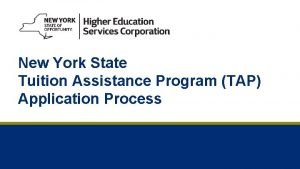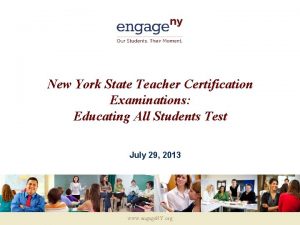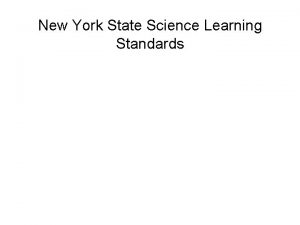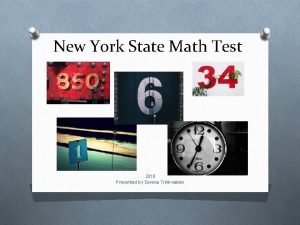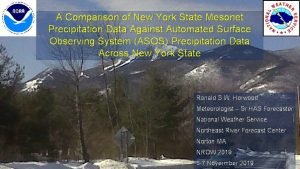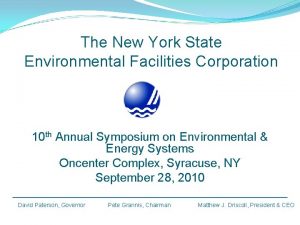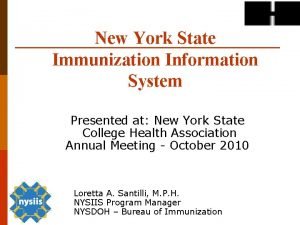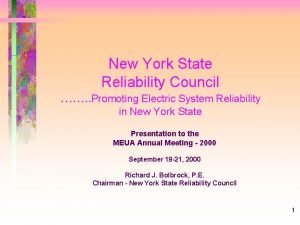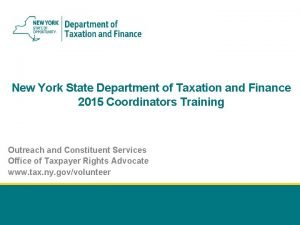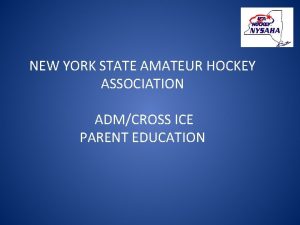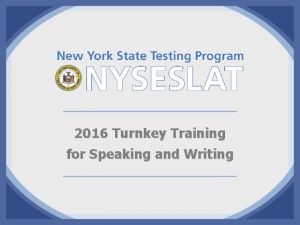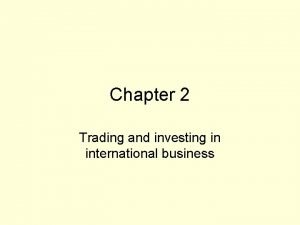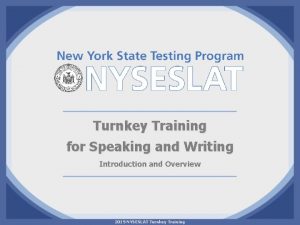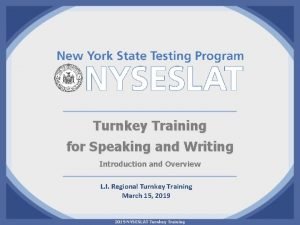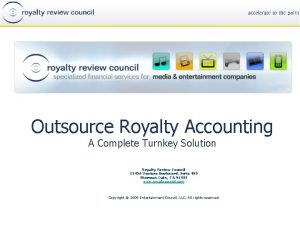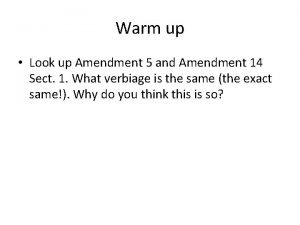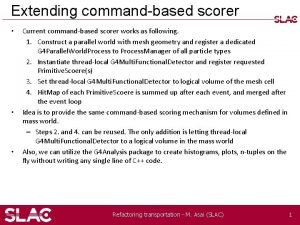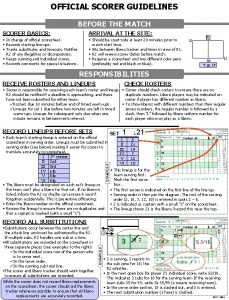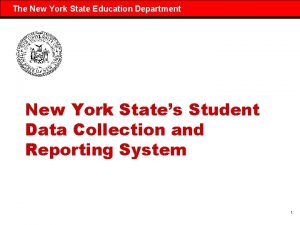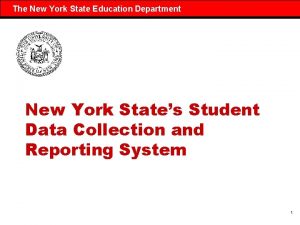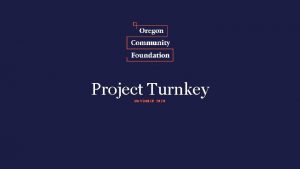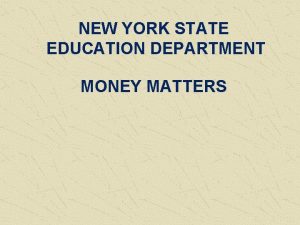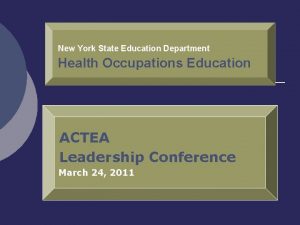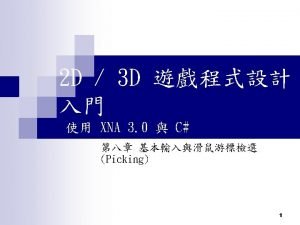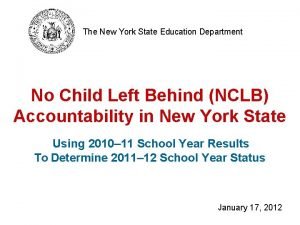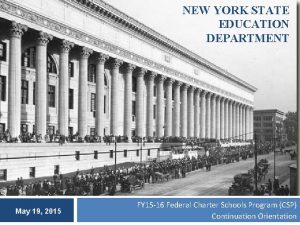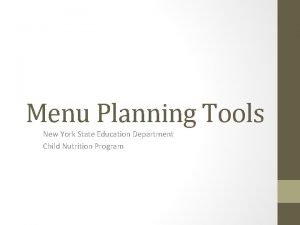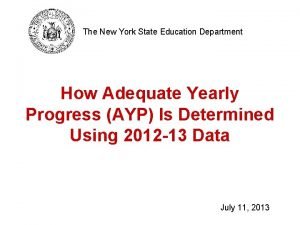The New York State Education Department Turnkey Scorer









































- Slides: 41

The New York State Education Department Turnkey Scorer Training for Enduring Issues Essay September 20, 2018 Daniel King Associate in Instructional Services in Social Studies Donna Merlau Associate in Instructional Services in Social Studies University of the State of New York State Education Department

Enduring Issues Essay

Preparing to Score • Raters read the documents of the Enduring Issues Essay. • Raters identify issues presented in the Enduring Issues Essay. • Raters discuss possible issues and summarize expectations.

Preparing to Score • Raters review the scoring notes. • Raters review the content-specific rubric. • Raters review anchor papers, matching evidence from those papers to the rubric. • Raters practice scoring on practice papers and discuss.

Holistic Scoring Overview When scoring • Read thoroughly, yet quickly, to gain an impression of the entire response • Read the entire response before determining a score, and then promptly assign a score.

• Scores must be determined based on the application of the content-specific rubric provided by NYSED. • The anchor papers and practice papers that you review will serve as examples of what a student response at a particular score level should look like. • The content-specific rubric is not a checklist.

Important points to keep in mind • The quality of handwriting, the use of cursive or printing, margins, editing marks, cross-outs, and overall neatness are not part of the scoring criteria, unless the response is completely illegible and nothing can be read.

• It is important for each reader to set aside his/her biases in order to keep the scoring as consistent and as fair to each student as possible. • You are scoring a State examination, not grading a classroom assignment, therefore, personal classroom grading practices should be set aside while scoring.

Comparison of Rubrics Generic DBQ Rubric 2004 Enduring Issues Rubric

Comparison of Rubrics: Similarities • The 3 rd bullet on the draft GHG II Enduring Issues Essay Rubric is the same as the 2 nd bullet on the current Global History and Geography DBQ Essay rubric. • The 6 th bullet on the draft GHG II Enduring Issues Essay Rubric is the same as the 6 th bullet on the Global History and Geography Essay Rubric.

Comparison of the Rubrics: Differences • Bullets 1 and 2 on the draft GHG II Enduring Issues Essay Rubric assess the extent to which the student has accomplished the task. In the current Global History and Geography DBQ Essay Rubric, only bullet 2 assesses how well the student has accomplished the task.

Comparison of the Rubrics: Differences • Bullets 4 and 5 on the draft GHG II Enduring Essay Rubric assess the extent to which students incorporate relevant facts, examples, and details from the documents and from outside information. In the current Global History and Geography DBQ Essay Rubric, bullets 3, 4, and 5 are used to assess the extent to which the students incorporate relevant facts, examples, and details from the documents and outside information.

The Six Primary Scoring Criteria for the Commencement-Level Enduring Issue Essay The extent to which a response • develops the task by identifying and defining an issue • develops the task by arguing how enduring issues affected people/people affected issues/continuity/change • utilizes higher level thinking skills • supports ideas with facts, examples, and details from the documents • supports ideas with facts, examples, and details using relevant outside information • organizes and develops a social studies essay

When holistically scoring, no one bullet can hold a particular score point hostage • • Number of Documents Minor Errors Outside Information Copying Document Information

Number of Documents

Can a paper still be given a score of 5 when the student did not use the minimum number of documents required? • Yes, because it is only one of the criteria on which a score is based. If fewer than the minimum number of documents are used and all other criteria of a 5 are met, then it may be a 5 paper. However, when fewer than the minimum number of documents are used, other criteria are often not being met, and thus it usually ends up as a 2, 3, or 4 paper.

Minor Errors

Can a paper be given a score of 4 or 5 if it contains a minor error or two? • If the paper clearly demonstrates that the task was understood and meets the criteria for a score of 4 or 5 on the test specific rubric, then, the paper can be given that score. • A paper does not have to be perfect to reach a score of 5.

Outside Information

How does “outside information” fit into the overall scoring of the essay? • The 5 th bullet must not be overemphasized in scoring. • A response may receive a 3 without outside information. • However, a response with outside information is not automatically a 3.

• The quantity and quality of the outside information, the relevance of the outside information to the topic, and how it has been integrated into the essay should be used when determining the score of a response.

What constitutes outside information? • It is information or details related to the identified enduring issue but not provided in the documents. • It can be social studies knowledge from 9 th or 10 th grade Global, from United States history, or personal experience as long as it is related to the identified enduring issue.

• Many topics in Global and United States history are intertwined. (World War I, the Cold War, the Middle East, Vietnam Conflict, Persian Gulf War, International treaties, etc. ) • While the United States should not be the focus of the argument, issues related to the United States may be used to address the argument as long as the information relates to the enduring issue identified from the documents. (Water pollution in Flint, Michigan)

• Often outside information can improve the overall essay when it is used to make historical connections and show analytical thinking.

• All papers need to be evaluated based on the rubric. If the paper demonstrates that the response minimally develops the task, is primarily descriptive with weak or isolated information, has a general plan of organization, and includes outside information, the paper is probably more of a 2 than a 3.

Copying Document Information How should you rate an Enduring Issues essay when most of the response is copied directly from the documents and little or no original work is provided?

• A distinction needs to be made between paraphrased or copied information that is used to support a specific idea within the essay (an appropriate social studies skill) and the outright copying of information from the documents in an attempted response to the Enduring Issue Essay.

• Generally, when most of the information is copied directly from the documents without adding anything, the response will be rated between a 0 and a 2.

The rubric for the Enduring Issue Essay addresses this issue • Score of 2: “or consists primarily of relevant information copied from the documents” • Score of 1: “or consists primarily of relevant and irrelevant information copied from the documents” • Score of 0: “includes only entire documents copied from the test booklet”

The actual score will depend on three things: • the degree or extent to which the response has been copied, • the selection of what specific content was copied for inclusion, and • how the copied material was integrated into the response.

What criteria helps define a score of 5? • A 5 paper shows evaluation and/or analysis. • It requires substantial outside information that is well integrated into the response. • It contains historically accurate information. • Document information is used to support thesis of the response and is interwoven with outside information. • It is cohesive and thoroughly developed.

• A 5 is not a 5 just because it is the best response that exists out of all the responses being graded. • A well-written response that contains numerous historical inaccuracies or repeats information over and over again is usually not a level 5 paper. • The response needs to meet the criteria established by the rubric. On occasion, a particular essay question may have no papers at level 5.

What often distinguishes a level 4 paper from a level 3 paper? • A 4 paper is both analytic and descriptive. • It addresses all aspects of the task but may do so unevenly. • It requires outside information that is integrated into the response. • It contains historically accurate information. • Document information is used to support thesis of the response and is interwoven with outside information. • It is well developed.

• A 3 paper is more descriptive than analytic. • It usually contains some outside information but it may not be well integrated. • It contains supporting facts and details, but may also have some minor inaccuracies.

What often distinguishes a level 3 paper from a level 2 paper? • A level 3 response contains more explanatory statements and specific details than a level 2 response. In an Enduring Issues essay, the documents are used to support thesis of the essay. • A level 3 response should include outside information, but it may not. However, most solid level 3 papers do include outside information.

• A level 2 response tends to have broad general statements. • Use of supporting information and information from the documents is limited. • Note: While a level 2 paper is not required to include outside information, it may contain some.

What most often distinguishes a 0 paper from a level 1 paper? • If a response is solely comprised of information copied from the task and from the documents without any information provided by the student or accurately interpreted by the student, then the response is probably a 0.

• A level 1 paper is NOT a paper in which the student simply “attempted” an answer. It must have some appropriate, original information.

• The goal of scoring is to be sure the scoring criteria in the rubrics are accurately and consistently applied to each student response being rated across New York State.

Reminder: • The rubrics define a set of scores on a continuum between 0 and 5. A standards-based assessment system measures where the student falls on that continuum.

Questions or comments? • For Assessment Questions Contact: emscassessinfo@nysed. gov • For Curriculum Questions Contact: emscurric@nysed. gov
 Scorer and assistant scorer
Scorer and assistant scorer Nysdot hdm chapter 5
Nysdot hdm chapter 5 New york city department of youth and community development
New york city department of youth and community development New york nurse practitioner association
New york nurse practitioner association New york tap application
New york tap application New york state teacher certification examinations
New york state teacher certification examinations New york state standards science
New york state standards science New york state test 2018
New york state test 2018 New york state mesonet
New york state mesonet New york state vegetable
New york state vegetable Gigp 30
Gigp 30 New york state professional firefighters association
New york state professional firefighters association Ny immunization registry
Ny immunization registry New york state association of transportation engineers
New york state association of transportation engineers Nys industries for the disabled
Nys industries for the disabled New york state division of criminal justice services
New york state division of criminal justice services Nysrc
Nysrc Ny tax practitioner hotline
Ny tax practitioner hotline Rn scope of practice ny
Rn scope of practice ny New york state fish
New york state fish New york state nickname
New york state nickname Emedny formulary
Emedny formulary New york state amateur hockey association
New york state amateur hockey association New york state county highway superintendents association
New york state county highway superintendents association New york, new jersey, pennsylvania, and delaware
New york, new jersey, pennsylvania, and delaware Marquee cinemas orchard 14
Marquee cinemas orchard 14 Articles of confederation strengths and weaknesses
Articles of confederation strengths and weaknesses Leanne keene french ambassador arrives from paris
Leanne keene french ambassador arrives from paris Oklahoma state department of education standards
Oklahoma state department of education standards Booking com preferred partner program commission
Booking com preferred partner program commission Nyseslat turnkey training
Nyseslat turnkey training Turnkey compliance solutions
Turnkey compliance solutions Turnkey project in international business
Turnkey project in international business Turnkey cluster
Turnkey cluster Turnkey project in international business
Turnkey project in international business Nyseslat speaking score sheet
Nyseslat speaking score sheet Nyseslat turnkey training 2019
Nyseslat turnkey training 2019 Royalty review council
Royalty review council Myfile york
Myfile york Barbara pacher
Barbara pacher Gitlow v new york constitutional question
Gitlow v new york constitutional question Merriweather library
Merriweather library




